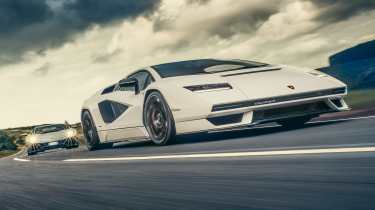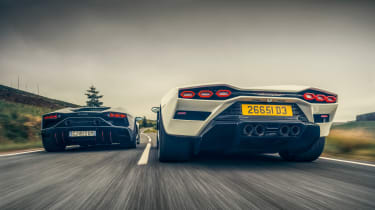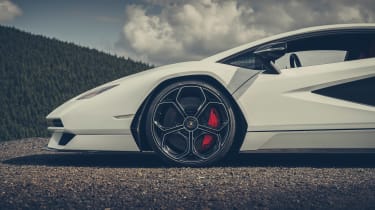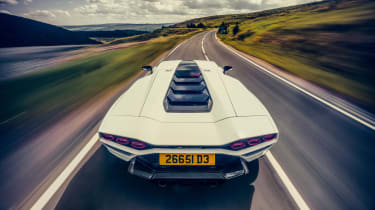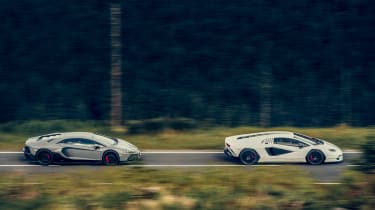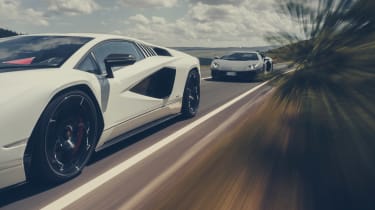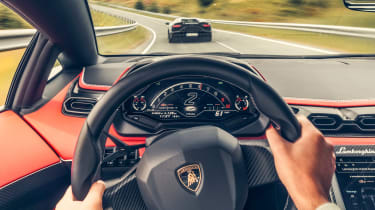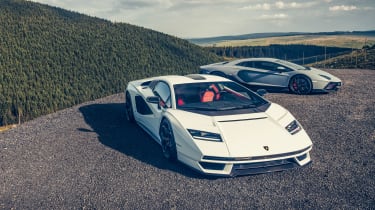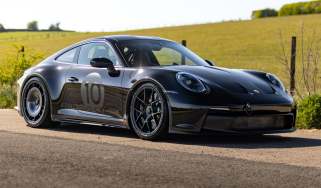Lamborghini Aventador Ultimae v Lamborghini Countach
They’re the last of the breed, a final hurrah for Lamborghini’s pure-combustion V12s. We head for the hills to compare the brilliant Aventador LP780-4 Ultimae with the jaw-dropping, £2million Countach LPI 800-4
The Thrill of Standing and Staring has its place, but here at evo we don’t often critique the styling of cars. Beauty is in the eye of the beholder, so we only occasionally offer an opinion, often based on us being among the first to see a new car ‘in the metal’. That doesn’t quite work here though, because the Lamborghini Countach LPI 800‑4 exists as an homage to the original Countach LP400, revealed as a concept to a gob-smacked world at the Geneva motor show in 1971.
The Countach was created to celebrate the 50th anniversary of that event and was revealed as a limited-run production car at Pebble Beach last August. It’s fair to say that Marcello Gandini, who styled the original Countach for Lamborghini when working at Bertone, wasn’t a fan. ‘I have built my identity as a designer, especially when working on supercars for Lamborghini, on a unique concept,’ he declared. ‘Each new model I would work on would be an innovation, a breaker, something completely different from the previous one.’ The LPI 800‑4 is anything but forward-looking, of course.
> Lamborghini Revuelto 2023 review – a worthy successor to the Aventador?
I’m fortunate to have driven and spent time with an original Countach LP400 and it was an incredible experience. It was yellow and for sale for £40k, but that was in 1993 and I didn’t earn half that annually. As a kid in the early ’70s, I idolised the black-and-white profile shot of the Countach in my Observer’s Book of Automobiles. It looked like the future back then and it still looks sensational five decades later.
More reviews
Group tests
- Alpine A290 v Alpine A110 – how much DNA do they really share?
- Ariel Atom 4R v Caterham Seven ‘evo25’: power-to-weight heroes go head-to-head
- Aston Martin Vantage vs Audi R8 V10 RWD – back to basics
- Caterham Super Seven 600 v Super Seven 2000
- Levante v T1
- Corvette Stingray v Porsche Cayman GTS v Audi R8 RWD
- Great Ferrari hypercars driven: 288 GTO, F40, F50 and Enzo head-to-head
- Lotus Emira v Morgan Plus Four – four-cylinder Brits go head-to-head
- Toyota GR86 v BBR Mazda MX-5: supercharged drop-top battles sports coupe
- Pagani Huayra Codalunga v Huayra Roadster BC – £10m of hypercar siblings go head-to-head
In-depth reviews
- Abarth 600e 2025 review – Italy gives the Alpine A290 something to worry about
- Alpine A110 review – distinctive, lightweight and unforgettable to drive
- Audi RS7 Sportback Performance review
- Bentley Continental R Mulliner: review, history and specs
- BMW 5-series review – is this still Munich’s anchor model?
- BMW 1-series review – Munich’s Audi A3 rival gains focus
Long term tests
- Abarth 695C Turismo Fast Fleet test – 10,000 miles in the Italian hot hatch
- Alfa Romeo Giulia Veloce Fast Fleet test – 7000 miles in the sharp Italian saloon
- Alpina B10: end of term report
- Alpina B10
- Ford Mustang GT
- Ford Mustang GT
- Ford Mustang GT
- Land Rover Defender 110 Fast Fleet test – 9000 miles in the go-anywhere SUV
- Maserati Ghibli Trofeo Fast Fleet test – 4000 miles in the Ferrari-powered saloon
- Mitsubishi Evo MR 340
Review
- New Aston Martin DBS 770 Ultimate review – 759bhp super-GT driven
- New Bentley Batur 2023 review – can it possibly be worth £1.65m?
- 2023 Chevrolet Corvette C8 Z06 review – the American 911 GT3?
- Kia EV6 GT-Line S prototype review – the EV that shows how it’s done
- BBR Supercharged Mazda MX-5 (ND) 2023 review – tuned 250bhp roadster driven
- MG4 Trophy 2023 review
Reviews
- Abarth 695 75 Anniversario edition 2024 review – a fitting send-off for Abarth’s hot supermini?
- Abarth 500e 2023 review
- AC Cobra 378 Superblower MkIV 2021 review – another V8 Cobra, but with a GM heart this time
- Acura Integra Type S 2024 review – a Honda Civic Type R with added restraint
- Alfa Romeo Giulia 2025 review – get one while you still can
- Alfa Romeo SZ: history, review and specs of an icon
- Alfa Romeo 1750 TBi
- Alpina B3 GT Touring 2025 review – a 190mph alternative to the BMW M3 Touring
Personally, I think it’s especially difficult to produce modern interpretations of cars built before low-profile tyres were introduced – their balloon-like tyres and tiny wheels are an integral part of the look. That’s certainly the case with the original Countach. The idea of a new version based on the Aventador sounded wrong (I wasn’t a fan of the 2006 Miura Concept either) but at the very least it would test the theory that ‘it would still look like the future today’. Meeting it in the metal, I think it does, but in a limited and specific way.
Current safety regulations, particularly in relation to crash protection, mean that a modern Countach couldn’t be as remarkably small as Gandini’s unadorned original. I guess it could have been based on the smaller Huracán but that’s a V10 and its squarer dimensions would have resulted in an even chubbier-looking car, like a Countach that swallowed a melon. So the LPI 800‑4 Countach is a much bigger car than the original.
Lamborghini styling can get more outrageous the older a model gets, as if trying to maintain the visual impact of the original. The Aventador SVJ was a riot of add-ons, details and decals and the LP780-4 Ultimae is fussy too. Mind you, the Countach 25th Anniversary was rather ‘busy’. I wonder what Gandini made of that, visually weighed down as it was by body addenda designed by one Horacio Pagani…
In a way, the Countach is like a remake of a cult movie: bigger budget, more spectacular and with the odd ‘easter egg’ thrown in to delight those in the know. There are the obvious features like the jagged wheelarch shape (just on the rear on the original), the NACA side scoop (greatly exaggerated), the shape around the rear lights, and headlights that look like the LP400’s combined front indicators and side lights. There’s even a nod to the ‘periscopio’ rear-view mirror of the original in the form of a sunroof shaped like that roof channel, which can be made opaque at the touch of a button. I’m not convinced by the side profile, which is a bit thick, but see the nose in the rear-view mirror or catch a glimpse of the clustered exhausts and you instantly think ‘Countach!’
I exclaimed something similar when I was told the price – 2million euros plus taxes, so about £2million here in the UK – but there will be only 112 examples, a reference to the development code of the original Countach, LP112. Also, it is based on the most potent of the Aventador spin-offs, the limited-run Sián FKP 37, with a 769bhp, 6.5-litre V12 boosted by a further 34bhp by a supercapacitor powering an electric motor built into the drivetrain. That’s 803bhp in total. So the supercapacitor gives the Countach the edge over the 769bhp Ultimae, of which 600 examples are being built (350 coupes, 250 roadsters).
The Ultimae is in a truck en route for the Borders when I get my hands on the Countach. The plan is to meet photographer Dean Smith in the hills later this afternoon, and pointing the white wedge through Hawick, heads swivel everywhere. You can have your new Countach in many of the colours offered on the original and although you might expect the demonstrator (car 0) to be orange, yellow or green, judging by the attention it’s getting, white clearly works very well.
The shifts of the automated single-plate clutch are a bit uncouth but I’m more bothered by the ride. Hawick isn’t home to the smoothest tarmac, but the Countach seems to be making a mountain out of every molehill, crashing and clattering along, every lump and bump registered and relayed. There are sophisticated adaptive dampers as standard but it feels like a fixed set-up that will come into its own when the speed picks up – as indeed it does. First, though, there’s the steering to acclimatise too. It’s light and direct, giving an over-bright response at low speed that you hope won’t be there at speed because it draws attention to where the masses are – the nose light, the wide tail heavy. As the pace picks up out of town, the road becoming faster but serpentine, the damping finds its range, the Countach’s nose tracking crests and compressions with a pleasing precision, clatter replaced by composure, the directness of the front end now suggesting that you can lean in, push on, see how much grip there is.
You want to, of course, because at your back is over 800bhp and in front is an instrument pack with a huge central tacho red-lined at nearly 9000rpm. There’s not the noise I was expecting though. Initially there’s the rich bass you expect from the 6.5-litre V12, but it soon becomes a busy, impure sound, the V12 beat there but subsumed beneath a cacophony of extraneous, irrelevant and less attractive noises that at times include a light, electrical whine.
Maybe it just needs to clear its throat, I think. There are a couple of straights here, so the tacho needle gets past 6000rpm a couple of times… but I can’t tell you exactly what the V12 sounds like as it lunges for the red line because my concentration is required in other areas, mainly dealing with the fact that the road suddenly got shorter and the scenery is arriving at a terrifying rate. The sense of all that mass bowling along behind becomes more acute again, too.
Back off and on the overrun there’s a distant fusillade that’s obviously the work of multiple tailpipes, but I still feel that under power the noise that comes from them and the mighty V12 is neither as pure or as loud as it could be, given the bespoke, four-pipe set-up. However, when I pull into the parking area and roll to a halt beside Dean, he’s wearing an expression that says ‘I suppose you’re pleased with yourself?’ Turns out he could hear it coming for miles, an earth-shattering noise that reverberated around the hillsides minutes before my arrival. Oh, right.
Heading back through Hawick high street later, I drop the windows, give the throttle a little squeeze and nearly jump out of my own skin. It’s not so much the booming engine note as the sharpness and volume of the overrun pops, which cut through and ricochet off the tall buildings like an ear-splitting barrage from a frigate. So, it wasn’t just the sharp styling and rarity that had the heads of the people of Hawick swivelling.
Rush hour the next morning is as entertaining as the evening before, now with 24 cylinders of Lamborghini rumbling through town, led by the Ultimae. They might be much the same car under the skin, but the Ultimae sounds quite different from the moment you flick the safety on the start button and give it a press. The complex growl that erupts is much more like the sound we’ve come to expect from the Aventador V12: rich and deep, a strong, heavy pulse that quickens briskly with a squeeze of throttle. Oddly enough, the two cars don’t sound so different from the outside.
The seats and ergonomics are the same but the ambience of the Ultimae is quite different, the whole interior trimmed in black Alcantara with white stitching whereas the Countach is very tidily tailored in red and black leather, like an homage to the men’s bedding section of the Grattan’s catalogue, circa 1980. Even so, the Countach feels more modern with its 3D-printed air vents, less arcade game-like instrument pack and cleaner centre console.
From the moment its wheels start turning, the Ultimae feels like a different car. There’s more polish to the shifts, and where the Countach crashed the Ultimae glides, effortlessly dealing with asphalt imperfections, smoothing over the ruts and ridges, absorbing the bumps, while the untroubled steering has a perfect heft to it. It feels so good. I can guess what staffer Jordan Katsianis behind in the Countach is thinking because I was in his place yesterday: if it feels like this around town, what’s it going to feel like at speed on a challenging bit of road?
The Ultimae, meanwhile, just gets better and better. As the road that climbs out of Hawick starts to duck and dive, the Ultimae steers keenly but in an unhurried way, the chassis remaining neutral, balanced. There’s plenty of grip to push against and the clear voice of the V12 gives a better sense of the amount of performance you’re asking the chassis to deploy.
It’s a phenomenal engine brimming with character and bursting with performance. There’s a decent amount of torque and a lovely brogue to the note if you hold a high gear and ask the big V12 to dig deep, but it’s at its most thrilling when you keep the throttle pinned past 6000rpm. The sound and seemingly exponential acceleration are stunning, and the chassis gives you the confidence to carry momentum into the next corner.
Even at speed, the Ultimae’s ride continues to deal with the road with remarkable adeptness and control. While you have to be conscious of its size on narrower sections, threading between hedgerow and centre line, you can place the car with precision. What’s more remarkable, though, and probably adds to that precision feel, is that you’re rarely aware of just how much mass is behind you. The SVJ was very good – dynamically transparent, poised and approachable and thus remarkably exploitable for a big, mid-engined supercar – but the Ultimae takes that to another level.
I arrive at the photo location smiling, enthused. Jordan arrives a little after, looking slightly spooked. ‘Well… that’s a little disjointed… a little rough around the edges,’ he says. Yes, but look at it: so clean compared with the Ultimae, which is far from being the most ornately detailed of the line. Jordan is not convinced. ‘There’s just something not quite right about it. It’s heavy where it should be light and too square where it should be curved.’
Another blat in the Countach reinforces the early impressions of its dynamics. There’s less balance compared with the Ultimae; the nose is light and direct, which is encouraging, but there comes a point where it feels the rear can’t keep up, can’t match its keenness, and suddenly you start to feel its weight. The upshot is that you don’t feel confident about maintaining momentum and committing to corners, the drive becoming point-and-squirt rather than the delicious flow you get into with the Ultimae. Both wear the same size Pirelli P Zeros – 255/30 ZR20 up front and 355/25 ZR21 astern – but on the Countach they’re the sportier Corsas, and that doesn’t seem to help. It’s almost as if the two models represent the start and end of the Aventador’s dynamic development, the Countach the start, the Ultimae the evolutionary peak; it comes as close to disguising the location of its engine as any V12 Lambo has.
Its replacement marries a hybrid V12 power unit with a dual-clutch gearbox and I for one won’t miss the automated single-plate clutch. At an amble, it’s acceptably refined in the Ultimae and a bit clunky in the Countach, but if you want to make smooth progress at a moderate pace in either, you need to get involved, bring some finesse to it. I tolerate it but Jordan relishes the engagement: ‘A dual-clutch doesn’t involve you in the process, the single-clutch needs mastering,’ he says. ‘This layer of input and finesse that’s required finds a sort of mid-point between manual and automatic; it keys you further into the experience.’
So far, the more powerful Countach hasn’t shown any discernible performance advantage over the Ultimae. Mind you, the additional 34bhp that comes courtesy of its supercapacitor is offset by the weight of said supercapacitor and associated gubbins (34kg), which contributes to the Countach being that bit heavier overall (1595 v 1550kg, dry). Their performance figures are almost identical, both claiming 0-62mph in 2.8sec and a top speed of 221mph. There’s just one quoted stat that differs, the Countach said to be a tenth quicker from 0 to 200kph (124mph) at 8.6sec.
But while any advantage is barely measurable on the watch, the feel is significantly different because the supercapacitor-driven electric motor incorporated into the driveline of the Countach fills in the torque gap left on upshifts by the automated single-plate clutch. And it’s in the Corsa drive mode that the benefit is most apparent (there’s an additional bonus, but I’ll come to that). Find a straight, select Corsa and nail the throttle. What normally happens when you pull for an upshift, what happens in the Ultimae, is that there’s a big pause as the engine revs drop, followed by an uncomfortably brutal thump as the next gear goes in and power is reinstated. But in the Countach there’s no pause, so shifts are much smoother and the acceleration seems to keep on flowing. If, like me, you have issues with the lack of mechanical sympathy that normally accompanies the aptly named Corsa mode, it’s like magic.
The other big bonus is that the Countach feels better dynamically in Corsa mode. The steering gets more weight, which isn’t always a plus but here it slows down the response so the car feels calmer, and the damping seems to add further control, which is exactly what you want. The performance is staggering, the chassis harnesses it and so it simply becomes a case of how brave you are. It’s so intense that occasionally you find you’ve forgotten to breathe. Astonishing: at the press of a button, the Countach becomes a proper weapon.
I’ve just discovered this when Jordan arrives back in the Ultimae from what will probably rank for some years as the most epic sandwich run he’s done. He’s rather animated. ‘You wouldn’t think a car with a huge V12 in the back could drive with so much finesse and alacrity,’ he enthuses, ‘but it does. And it instils so much confidence. The nose is incredibly accurate and builds up to a gentle grip threshold, the rear end is totally locked on and resolutely follows the nose without the rear-steer being apparent.’ It’s quite the revelation for someone who had a Lamborghini poster on his bedroom wall as a kid. ‘It’s one of the most involving and exciting cars I’ve ever driven, and the transmission and sheer width only add to the experience.’
On that last note, I tell him to have another go in the Countach, in Corsa mode. It’s an amusing few minutes for me, chomping on a sarnie, listening to the ebb and flow of a 6.5-litre V12 reflecting off hillsides in a seemingly random way, before the Countach heaves back into view looking sensationally sharp and dynamic, another convert on board. ‘I’ve never felt anything like it,’ says Jordan. ‘You can feel the ignition cut, but instead of a violent thump to your lower back, that high-energy surge takes all the teeth-grinding stress out of the changes.’
They’re quite something, this pair. The Ultimae fully lives up to its name; it’s the last and the best Aventador we’ve driven, a fitting and desirable finale. We’re big fans of the SVJ but this car takes all of its ability and adds even greater balance and composure, so that, if you want, you can exploit all of the magnificent V12’s performance without feeling like it’s dictating the terms. And if you don’t want, you have a car that will just as happily mooch around town, ironing out surface imperfections and turning heads. Dynamically, there’s very little we’d change.
There doesn’t seem any good reason why the new Countach couldn’t be as dynamically sorted as the Ultimae, or sound as good from inside, but that’s how it is. It does come dramatically good in Corsa mode, although, as mentioned earlier, the supercapacitor hybrid solution addresses a very specific issue that doesn't exist with the Revuelto replacement, because that car uses a dual-clutch transmission. Read Jethro Bovingdon's verdict here...
Specs
| Lamborghini Aventador LP780-4 Ultimae | Lamborghini Countach LPI 800-4 | |
| Engine | V12, 6498cc | V12, 6498cc |
| Power | 769bhp @ 8500rpm | 803bhp @ 8500rpm |
| Torque | 531lb ft @ 6750rpm | 531lb ft @ 6750rpm |
| Weight (dry) | 1550kg | 1595kg |
| Power-to-weight (dry) | 504bhp/ton | 511bhp/ton |
| 0-62mph | 2.8sec | 2.8sec |
| Top speed | 221mph | 221mph |
| Basic price | £324,000 | £2m |
This story was first featured in evo issue 300.

